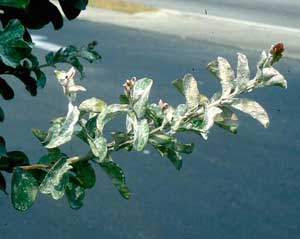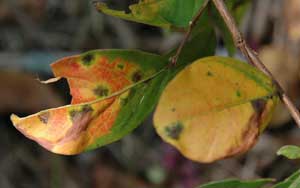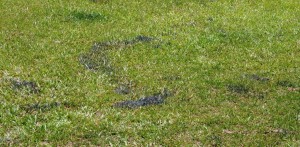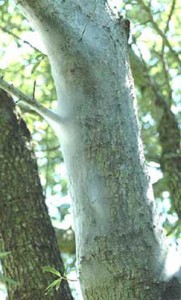
by | Jul 1, 2013
This summer parts of the Florida Panhandle have been blessed with ample rain, but coupled with high temperatures, this can be both a blessing and a curse.
Adequate moisture is critically important to landscape plants during hot weather, but too much rain or excessive watering also can bring problems. Wet soil combined with high temperatures can create stressful conditions for bedding plants, vegetables, shrubs and even trees – especially those just planted this year.
When the soil is saturated with water, pore spaces in the soil, which normally hold air, are filled with water. Since the roots of plants get the oxygen they need from the air in those spaces, the roots can literally drown in a soil that stays waterlogged over an extended period.
In turn, a sick root system leads to a sick plant. Plants in such situations often lose vigor, look wilted, turn yellow, are stunted and often die.

Symptoms of Root Rot on Azalea
Wet soil conditions also encourage fungus organisms that live in the soil to attack the roots or crown of a plant, thus causing rot. The crown is the area where the stem of a plant enters the soil. These disease organisms can cause die-back, inflict severe damage or even kill plants. Worse yet, once infection occurs, little can be done to help a plant affected by these disease organisms.
Plants with succulent stems such as impatiens and begonias, those that like cooler temperatures such as geraniums and dianthus and those that prefer drier, well-drained soils such as Indian Hawthorns are particularly susceptible.
Gardeners can take steps to help alleviate the situation. First , it is critical to adjust irrigation systems that are on automatic timers. Often seen are sprinklers unnecessarily watering at homes or businesses the day after or during a heavy rain simply because the timer turned them on. Turn off the automatic timer if the weather is wet, and turn the system on only when drier conditions occur.

Home Irrigation Timer
Beds should always be well mulched, at 2-4 inches, to control weeds and maintain soil moisture. If garden beds are staying too wet, however, the mulch can be pulled back from around plants or removed entirely to allow the soil to dry faster. Just make sure keep weeds are kept under control while the mulch is off.
Plants affected by wet soils or root rot may look wilted even though the soil is moist. A plant showing these symptoms immediately after a period of prolonged heavy rain may benefit from soil aeration in its root zone. Using a garden fork by driving the tines straight down into the soil and pulling straight out in numerous places around the plant is helpful. This provides air to the roots and encourages the soil to dry faster. Just be sure you don’t dig with the fork.

Gardening Fork
Fungal diseases that attack the foliage of many plants also are encouraged by rainy weather. Black spot on roses is prevalent even on fairly resistant varieties, and control is nearly impossible if it rains every afternoon. Cercospora leaf spot and Powdery mildew on crape myrtles can cause the leaves to turn yellow or red and drop off. The disease is not fatal, and the trees will recover without sprays, but flowering may be diminished.

Powdery Mildew on Crape Myrtle

Cercospora Leaf Spot on Crape Myrtle
Other pests such as snails and slugs thrive and reproduce rapidly during rainy weather. These pesky critters chew holes in the leaves and flowers of plants and are particularly fond of soft-leaved plants such as impatiens, begonias and hostas. Try not to let their populations get out of control. Note that Toads should be left alone because they feed on slugs. There also are numerous baits on the market that will help control snails and slugs. You can even place a bowl up to its rim in the ground and fill it half full of beer to attract and drown many snails and slugs.
Frequent rains can leach available nutrients from the soil in the landscape. Landscape plantings should be evaluated with this in mind and be fertilized, if needed. If possible, controlled release fertilizer should be used in this situation. Plants rapidly growing now such as lawn grasses, summer bedding plants and tropicals like ginger and hibiscus are especially vulnerable.

by | Jun 21, 2013
Gardeners crave color in shady areas of their landscapes just as much as they do in sunny areas. Unfortunately, shade-loving plants generally are not so flamboyant, and the selection of colorful bedding plants for shady gardens is limited.

Thank goodness for caladiums. Even in fairly heavy shade they can be counted on to provide color through the summer.
Modern cultivars are primarily derived from caladium bicolor and its hybrids with other caladium species. They are grouped under the name Caladium x hortulanum. Caladiums belong to the arum family, which provides us with many tropical landscape plants and houseplants.

Multiple Varieties of Caladiums in Various Colors.
Caladiums are grown for their attractive foliage, which is produced from knobby brown tubers gardeners often call bulbs. The 6-inch to 12-inch, heart-shaped leaves emerge from the ground on arching stems that are generally 1 foot to 2 feet tall.
The foliage may be splashed with combinations of white, pink, rose, red, burgundy, chartreuse or green – often with several colors combined in wonderful patterns. These bright leaves, with their bold texture, embellish our shady gardens from May until October, when the tubers go dormant.
Caladiums also are remarkably free from major insect or disease problems and thrive in hot, humid weather.
They grow best in shade to part shade (two hours to four hours of direct sun, preferably morning sun). In those conditions they produce lush growth with large, colorful leaves.
Some cultivars are tolerant of more sunny conditions and are successful in beds receiving part to full sun (six hours or more of direct sun), but do avoid hot, dry, sunny locations.
Caladium plants you purchase at nurseries usually have been grown in shady greenhouses, so the foliage often will scorch or burn if you plant them into beds that receive too much direct sun. This results in brown areas and holes literally burned into the leaves. If the cultivar is sun-tolerant, new foliage eventually will emerge and adapt to the sunnier conditions, but I still think caladiums planted in full sun always seem to look stressed.

Typical Caladium Tubers Ready for Planting
You can buy caladium tubers now and plant them directly into well-prepared beds. By now, some nurseries have caladium tubers on special sales at a good price, and since our growing season is so long, it is not too late to plant them.
Caladium plants also are available growing in 4-inch to 6-inch pots. They will provide immediate color in the landscape. Plant them about 8 inches to 12 inches apart, and they will grow larger and more beautiful through the summer.
Careful bed preparation will ensure healthy, robust plants. Turn the soil in the area to be planted and then incorporate a 2-inch to 4-inch layer of organic matter such as compost, rotted manure or peat moss. Next, lightly sprinkle the area with an all-purpose fertilizer, following the directions on its package, and rake it into the upper few inches of the soil. As an alternative, a little slow-release fertilizer can be placed around each tuber as it is planted into the bed.
Caladium plants should be planted with the top of the root ball level with the soil of the bed. Plant unsprouted tubers about 2 inches below the soil surface. When planting tubers, you should see growing points or even pinkish-white sprouts on the knobby side of the tuber. That side is planted up. The smoother, rounded side is the bottom of the tuber.
Once they are planted, mulch the bed with 2 inches of your favorite mulch and water in. Keep beds of caladiums well watered during the summer, especially those receiving lots of sun.
The colorful, tropical foliage of caladiums combines beautifully with impatiens, begonias, torenias, liriope, ferns, achimenes, gingers and other shade-loving plants. They generally are more effective when a single color or cultivar is used in a bed or an area of the landscape. If several colors are used, they are most effective when masses or groups of each color are combined in the planting.
In late September or October, cooler temperatures encourage caladiums to go dormant. When grown with poor growing conditions, particularly in areas of deep, heavy shade, the plants will likely produce small, weak tubers that may not return well, whether they are left in the ground or dug and stored. Under the right circumstances and with proper care, however, the tubers you planted this summer can be dug in the fall and planted next April or left in the ground to provide a beautiful display again next year – and for years to come.
All types of caladiums thrive here when they are planted in partly shaded locations. The cultivar you choose is a matter of your individual taste.
Keep in mind that if you are going to be planting caladiums in a sunny location, try these cultivars for better success: Candidum Junior, Carolyn Whorton, Fire Chief, Rosebud, White Queen, Jackie Suthers, Lance Whorton, Miss Muffet, Mumbo, Pink Gem, Red Frill, Sea Gull and Florida Sweetheart.
by Beth Bolles | Jun 17, 2013
There are a couple of possibilities for gardeners who are looking for something a little different than the old favorite French hydrangea. If you want to make your neighbor’s and gardening friends envious, consider adding one of the following selections to your garden.
The first to consider is the ‘Limelight’ hydrangea (Hydrangea paniculata) which is a hardy shrub and performs well in sunshine. New leaves emerge each spring and large greenish-white blooms emerge in the summer. Blooms may offer a color change into the fall, adding a delicate pink shade. This hydrangea should definitely be installed where it can be viewed and can grow 6-8 feet in height with a similar spread. Once established, it can be tolerant of some drought but will require moisture during extended dry periods.

If you have a garden with more dappled shade, the ‘Fuji Waterfall’ hydrangea is a good selection. This hydrangea will require a soil with more consistent moisture and will offer interesting lacecap blooms that appear to cascade over the dark green leaves. Growth will have a layered look with plants reaching about 3 to five feet in height.

For more information on newer selections of hydrangeas for our climate visit the University of Florida publication New Hydrangeas for North and Central Florida: Bigleaf and Mountain Hydrangeas
by Matthew Orwat | Jun 17, 2013
Although black or white streaks are shocking when they appear on an otherwise healthy lawn, the incidence of slime mold is rarely harmful.

Closeup: Slime Mold in Centipedegrass. Image courtesy Matthew Orwat
Slime mold is actually caused by the reproductive structures of an array of different organisms, classified as plasmodia or Protista, which are regularly present in the soil. They are often mistaken for fungi. The different types are referred to as myxomycetes or dictyosteliomycetes. They usually appear on warm humid days in late spring or early summer after extended periods of rain. This extended period of heat and humidity, as is currently being experienced in the Florida Panhandle, initiates the perfect climate for slime mold development.

Slime Mold in Centipedegrass. Image Courtesy Matthew Orwat
As depicted in the picture above, slime mold makes the lawn look like it was just spray-painted with black or grey paint. The round fruiting bodies, called sporangia, carry the spores which will give rise to the next generation of the “mold”. After a few days the sporangia will shrivel up, release the spores and leave no noticeable trace on the lawn.

Slime Mold Sporangia. Image Courtesy Matthew Orwat
Currently, no fungicide exists to control slime mold because chemical control is not necessary. An excellent method to speed up the dissipation of slime mold is to mow or rake the lawn lightly. This will disturb the spores and hasten their departure. Another effective removal method is to spray the lawn with a forceful stream of water. This process washes off the slime mold sporangia and restores the lawn to its former dark green beauty.
Excessive thatch accumulation also increases the probability of slime mold occurrence.
For more information consult your local county extension agent or read the Alabama Cooperative Extension publication Slime Mold on Home Lawns.
by Larry Williams | Jun 17, 2013

Tree cattle webbing. Photograph by Douglas L. Caldwell, University of Florida
Many people are noticing small insects on trunks and branches of their trees. When disturbed, these insects move in a group and are commonly called tree cattle because of this herding habit. They are ¼ inch brownish-black insects with white markings. Some people assume that these insects will injure their trees but they are harmless. They could be considered beneficial.
Before you spray your tree to control these insects, click on the following link and read the entire article.
Tree cattle are harmless

Tree cattle. Photograph by Jim Castner, University of Florida


















